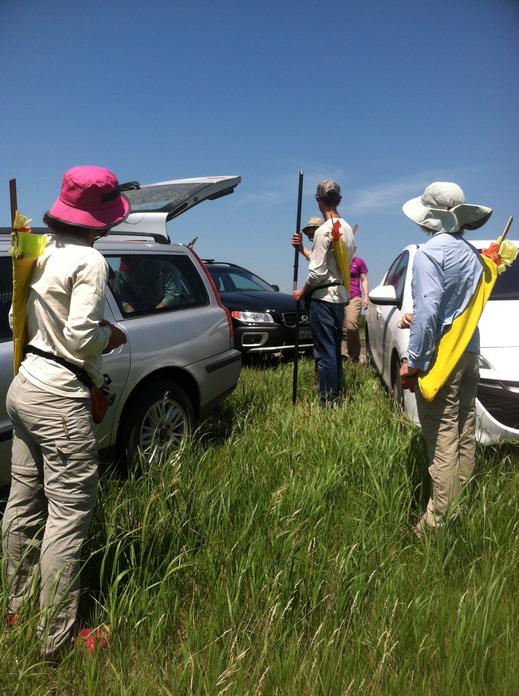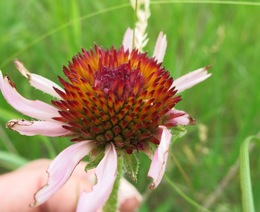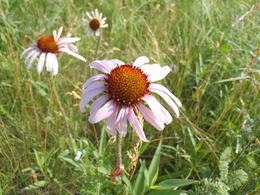|
|
Today the whole team was busy mapping and monitoring the phenology of Echinacea at numerous remnants. Although mosquitoes, gopher holes, and construction crews conspired against us, we were able to complete all monitoring before a bout of afternoon rain.
Here is a quick and dirty map of flowering Echinacea plants at Staffanson prairie that were mapped between 2011 and 2013. Please note that west, rather than north, is “up” on this map (the unusual orientation of this map is just for my convenience)…
sppmap
Having mutually pledged to the Echinacea Project our Lives, our Fortunes and our sacred Honor, we set out this fine Saturday morning to survey the flowering phenology of Echinacea in the prairie remnants. We are interested in phenology (the study of recurring phenomena) because just as distance can genetically isolate fragmented populations, so can time. Since Echinacea cannot reproduce with itself, it needs to be flowering at the same time as a compatible mate if it wants a chance to reproduce.
To quantify flowering phenology, we have to check on the flowers every few days. Echinacea is just beginning to flower now, and we don’t want to miss anything. Today we split up into two-person teams, went to different remnants, and recorded the progress of every flowering Echinacea. All our work locating and flagging plants earlier this week allowed us to move efficiently through the sites, finishing our survey by mid-day. Here we are converging at the final site:

A formidable crew undertaking a daunting task in pursuit of a noble goal: what a glorious Saturday!
It’s been a day full of giddy excitement for Team Echinacea. Not only was it a team member’s birthday, but on our first trip to the remnants we found the first flowering head of the season.
If you look carefully at the picture below you can see the first style on the bottom right.

This plant is number 1414, first tagged in 1997 in the KJ remnant. The upper florets on 1414 are not typical in form, and appear to be diseased. Bets are still on for the first flowering head in the experimental plots.
-Claire
Sarah Baker presented “Flowering phenology of Echinacea angustifolia in Minnesota tallgrass prairie remnants over three years,” the results of her summer 2013 REU project, at the National Conference on Undergraduate Research, University of Kentucky, on 4 April 2014.
Here’s the presentation…
Sarah_Baker_NCUR_Presentation_FINAL.pdf
Final consolidated file of ech. ang. flowering phenology data from 2011
Edit: now with sppe and sppw differentiated
2011DataFINAL.csv
Flowering phenology data from summer 2013. This version contains data collected from 7 July, 2013 to 26 August, 2013. PhenDataMASTERcsv_28-Aug-2013.csv
This morning, I went out to Staffanson to collect flowering phenology data and saw my first flowering Echinacea of the summer! Some had started flowering yesterday but a few started today. Awesome! 😀

Sarah B
Hi there everyone,
I was an intern with the Echinacea Project last summer (2012) and worked on the remnant flowering phenology project. Over my winter term at Carleton I worked on an independent study to analyze the seed set of some of the remnant plants. After finishing dissection and x-raying the achenes (with a lot of help from the lovely volunteers in Chicago!), I created a poster which I presented at the Midwest Ecology and Evolution Conference in March of this year. I have attached the poster to this post. Hopefully, it explains some cool findings!
Good luck with field work everybody!
kapsar_MEECposter.pdf
This summer I’m going to continue with Amber Z’s phenology research from last year. I’ve added on two new sites: North Northwest of Landfill and Around Landfill. I started taking data on June 18th when there were only a couple of plants beginning to flower, but now, many more plants have started flowering and a couple are even close to finishing!
Kelly’s Flowering Phenology Project Proposal.doc
|
|



